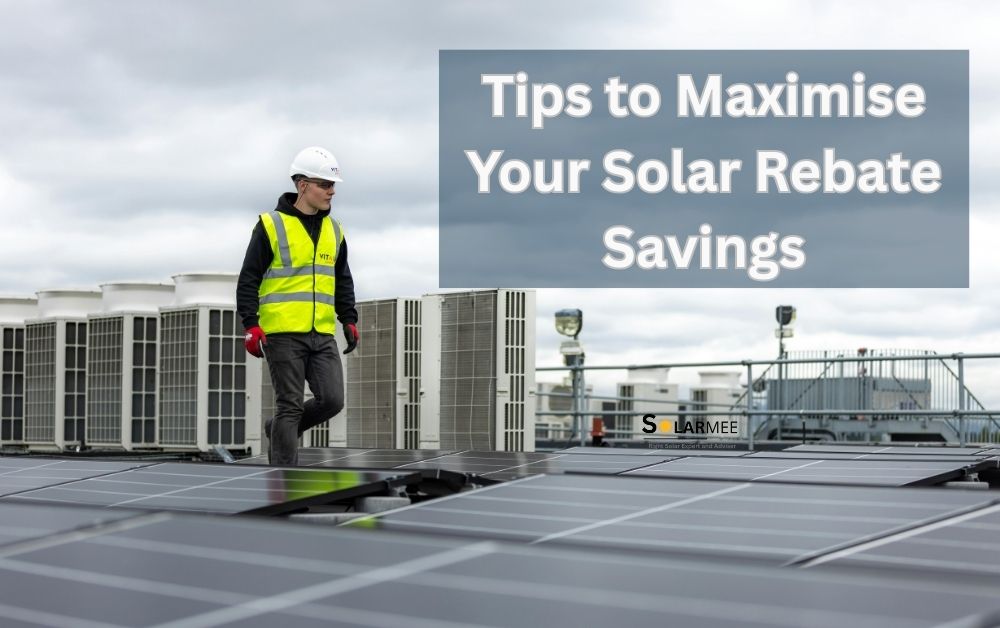The uptake of solar energy in New South Wales (NSW) is increasing, with more than 7.5 GW of rooftop solar capacity already installed in the state. Thousands of new systems are added annually, which makes New South Wales the Australian leader in terms of residential and small business solar capacity.
The rapid adoption can be attributed in part to solar panel rebate programs, which enable the use of clean energy to be much more affordable to homeowners and businesses. These government rebates reduce the cost of installation and, with the help of solar, have now become accessible to more households, increasing energy independence and sustainability.
Throughout this guide, the reader will have a clear idea about solar panel rebates in NSW: understand how the rebate programs can help, the eligibility possibilities of households and small businesses, and the advice of experts in finding the optimal savings.
The present blog is also a balanced review of the existing solar panel rebate program and its advantages, as well as its major considerations.
Solar Panel Rebates in NSW
Solar panel rebate is a government grant that lowers the initial expense of installing solar panels, and, therefore, clean energy is now affordable in NSW. Australia’s rebate system is in two levels, where the federal rebates are provided through Small-scale Technology Certificates (STCs), which automatically reduce the prices of the systems at the point of sale.
This is complemented by NSW-specific programs of extra refunds or interest-free loans – households could save up to $3,000, and the low-income earners could replace the annual energy rebates with the solar installation. The federal rebates (STCs) cover the whole of Australia and are administered by accredited installers.
Energy retailers who claim the rebate on your behalf and have it deducted from your initial cost. The income and property value thresholds of NSW programs exist. The state and federal government’s combined effort and installer facilitation guarantees that the government benefits of solar panel rebates are hassle-free.
Also Read: Solar Power Government Rebate Adelaide
Who is Eligible for Solar Rebates?
Solar rebates eligibility in NSW is based on a number of factors. In order to be eligible, the household must earn less than 180,000 a year, and the house should not be valued at more than 3 million pounds. The eligibility is only for systems that are installed by installers who are accredited by the Clean Energy Council (CEC) and installed with approved components.
To qualify for an existing solar PV system, households need to already have a system installed, but certain programs have the option of upgrading an existing system or small apartment buildings, and renters with landlord consent.
One of the frequent misconceptions is the distinction between “who is eligible for solar rebate (depending on the state and program) and solar panel rebate Australia eligibility, which denotes the general federal opportunities that all Australians have. NSW rebates tend to be more focused on income and property requirements.
Checklist:
- Not a business. NSW resident and property owner/renter (with approval).
- Household income below $180,000
- The housing price is less than 3 million dollars.
- Install CEC-approved installation and components.
- No available solar standard rebate.

How to Claim Your Solar Panel Rebate in NSW
| Step | Action | Details |
| 1. Research Installers | Find CEC-approved installers | Ensure the installer is Clean Energy Council accredited and check credentials. |
| 2. Get Quotes | Request multiple quotes | Compare pricing, rebate offers, and products from different installers. |
| 3. Confirm Eligibility | Review criteria and pre-check | Assess income, property, and system eligibility via the NSW government Solar Programs. |
| 4. Apply for Rebate | Apply via the installer/government | The installer typically manages paperwork and submits a claim, and provides necessary documentation. |
| 5. Install System | Complete installation process | CEC-accredited installer sets up system; rebate is deducted from upfront cost. |
Benefits of Solar Rebates for NSW Households
In NSW, solar rebates reduce the initial outlay to install solar panels, allowing solar power to be affordable to more residents. This decreases the payback period and the amount of the return on investment, as this lowers the energy costs at an earlier time.
The solar panel rebate programs will assist in achieving the renewable energy targets set by NSW, since they aim at promoting the use of clean energy.
Indicatively, a common 6.6kW solar system will help a homeowner to save about $1,000 in yearly electricity bills when the federal and state rebates are implemented. This not only makes solar a solution that is environmentally responsible but also a financially intelligent option.
Comparing NSW Rebates with Other States
In New South Wales (NSW), the main type of solar rebates available is the federal Small-scale Technology Certificates (STCs), with special attention to low-income households providing more battery rebates and interest-free loan options. Conversely, the Solar Homes Program in Victoria offers a maximum of a $1400 rebate on solar panels together with battery systems, which have interest-free loans and is therefore one of the most affordable and generous programs in the country.
Queensland has partial state rebates, but provides federal rebates with occasional incentives and interest-free loans, so as to encourage the affordable application of solar power. The rebate policy of NSW is moderate in cost but powerful in the accessibility of certain groups, whereas Victoria is the first one with a wider range of eligibility and higher levels of rebates.
The focus by Queensland on loans and feed-in tariffs promotes energy efficiency as opposed to initial subsidies. This overview creates a diverse landscape of solar panel rebate programs in Australia.

Tips to Maximise Your Solar Rebate Savings
The size of your solar system will determine how much solar or renewable energy you can save through the NSW government’s solar rebate program. Never hire any installer unless he or she has the Clean Energy Council (CEC) certification in order to meet the compliance and eligibility requirements for the rebate. Add to your solar panel installation rebate, other incentives such as feed-in tariffs and low-interest green loans.
Frauds: It is worth noting that such common errors as choosing inexpensive, non-approved panels or non-accredited installers may compromise the availability of rebates and the effectiveness of the system. Applying these tips will result in the highest savings and the profitability of the investment in the long term.
Real Reviews & Experiences from NSW Households
Most of the NSW households that have tried solar panel rebates have positive stories about the program and point out that major cost savings have been made and that there has been an easy and simple process to apply due to easy-to-use accredited installers. Users have been citing significant savings in initial installation costs and continued savings on electricity bills.
Nevertheless, certain difficulties also exist, including the fact that the processing of paperwork can take a long time, or sometimes misunderstandings related to the introduction of new rules of rebates or miscommunication on the part of the installer.
However, these concerns notwithstanding, the general response is equal and optimistic that the rebate programs have been successful in encouraging solar adoption, though some areas of improvement in the processes are possible. Such practical examples illustrate the functionality of the solar panel rebate government programs in actual life, which motivates more citizens to invest in clean energy.
Future of Solar Rebates in NSW
In NSW, the future of the solar rebates is changing since the government does not focus on the upfront rebates of batteries but is introducing new incentive mechanisms. The NSW Solar Battery Rebate, which is a component of the Peak Demand Reduction Scheme, formally expired on 30 June 2025.
In July 2025, the state also launched a larger Virtual Power Plant (VPP) incentive that provides up to $1,500 in incentives to battery owners who become connected to VPPs. This may be added to the new federal Cheaper Home Batteries Program, which offers more rebates and makes solar energy storage more affordable.
According to the experts in the industry, the attention will shift towards incorporating solar with smart grid technology instead of providing direct installation rebates. Although the use of traditional rebates can be phased out by 2030, the commitment of NSW to the use of renewable energy may still imply continuous support of its use by innovative programs.
Also Read: What is a Solar Panel Rebate?
Conclusion
The incentives associated with the solar panel rebates in NSW present good incentives, such as lower initial cost of installation, shorter payback time, and aid in achieving the renewable energy targets. The eligibility is based on household income of less than 180,000 dollars and the value of property of less than three million dollars, with the condition that it must use a Clean Energy Council-accredited installer.
Choose the right size of system, make sure to combine the rebates with other incentives, and use non-approved panels, which result in the highest savings. According to reviews, lots of NSW households can enjoy the cost-saving and the ease of the process, but some households experience the paperwork delays. Rebate values can go down with time, so it is best to verify eligibility and do it early.
Claim your solar panel rebate in NSW and maximize available savings by talking to an approved solar installer today.

I am Vanshika, a passionate writer, digital marketer, and explorer of ideas. With expertise in SEO, social media, content creation, and website design, I combine creativity with strategy to deliver impactful digital solutions. Writing is my way of sharing knowledge, sparking curiosity, and building meaningful connections with readers. Through my blog Vanshi’s Exploration, I share unique insights on finance, travel, technology, and future-forward thoughts that inspire and inform.




